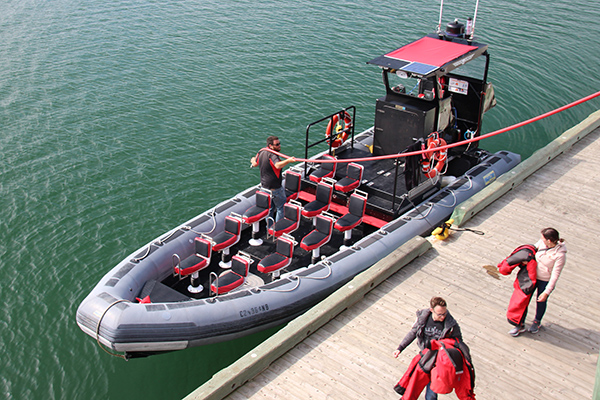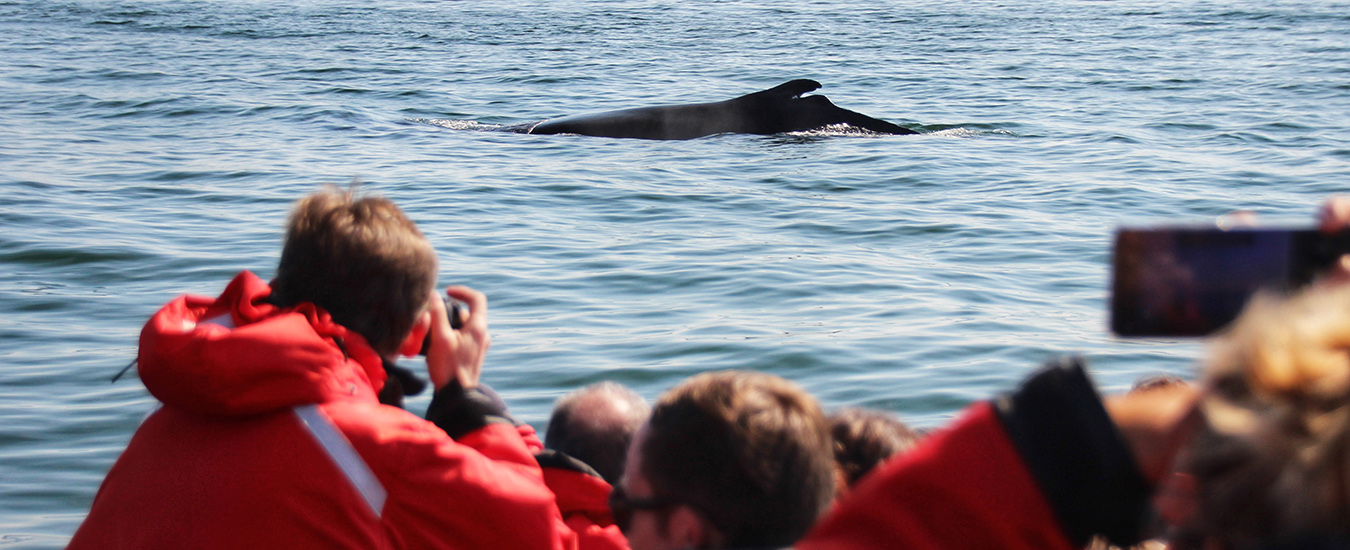Whale watching from aboard a former FBI jet boat
Story and photos by Darcy Rhyno
I feel like a dog with my head out the car window. We’re zipping over the calm waters of Passamaquoddy Bay out of Saint Andrews, New Brunswick like a sports car down the highway. Aboard this former FBI high speed jet drive Zodiac that goes by the name of Jolly Hurricane and reaches 65 kilometres per hour on a day like this, we’ll be on the whale watching grounds out on the open Bay of Fundy in no time.
We race past the 22-metre square rigged cutter, the Jolly Breeze of St. Andrews, another whale watching ship in this fleet, like it’s a school bus in the slow lane. Passengers exchange waves, everyone excited for the kind of adventure they favour. Aboard the Jolly Breeze, it’s a leisurely trip with a touch of the past, while ours is a crazy fast one with something futuristic about it. Aboard the Jolly Breeze, passengers are wandering about the wooden deck, drinks in hand, checking out the sails and webs of ropes. On the Jolly Hurricane, we’re dressed in puffy, orange survival suits, bobbing in our shock-absorbing seats like so many tanned minions in a weird Despicable Me spinoff.

“It’s certainly part of the adventure, getting into those suits,” says Joanne Carney, co-owner with her husband Rob Carney of Jolly Breeze Whale Watching, and our guide for the trip. I have to agree. The suits are comfortable and flexible, shielding me against the fierce wind caused by our speed. Rafts of seaweed, rocky coastline, beaches, lighthouses, rustic cabins along the shore, eddies in the currents between islands—all pass by as if we’re in a time lapse film.
Then our first whale. The captain cuts the engine. Just like that, not 50 metres from shore, a humpback whale blows a spout. Well, that’s what I’ve always heard a whale does, spouts water from its blowhole. But it’s more like a cloud of mist that hovers in the air as the sleek black back of this colossal sea creature rolls to the surface, exposing its dorsal fin. Once, twice and a third time it rises to the surface. With each pass, I try to imagine what it must be like to take in great gulps of air through a hole in the back, but it’s just too foreign a concept. These are wonderfully strange creatures.
On the third pass, the whale seems higher out of the water than before. We soon learn why—it’s diving. The great body of a humpback—it’s probably 16 metres in length, weighing in at something like 30,000 kilograms—angles down into the depths, bringing its widely-forked tail completely into the air. Water pours off it as the underside, marked with bright white patches, flips into view. Just before it slips without a splash below the surface, it is the exact shape of an upside-down moustache, curled ends and all.
Excitement hums among the passengers, then we’re on our way again. Now that we’ve put the last fingers of the mainland and the last of the near-shore islands like Bliss and White Horse behind us, we can see our destination—The Wolves. The waters around this string of five small islands is the most promising for spotting whales, dolphins, seals and seabirds. The jet drives are shoved into neutral and we coast to a quiet stop in front of Southern Wolf Island Nature Reserve. A fishing boat with a few folks enjoying a lazy afternoon on the water bobs near the cliffs.
“There are spots where whales tend to hang out,” Carney says. “It has to do with the currents and the shape of the ocean floor. The current tends to push the fish right around that island. It helps school the herring. Then the whales feed there.”
Sure enough, a behemoth rises from the depths and does its thing, spouting and inhaling, curling its body and at last diving, as if we weren’t even there. Long after the whale’s tail disappears, we’re left with what amounts to its footprint. As a whale dives, the downward motion of its tail (flukes) leaves a smooth patch of water where it disappears. In the days of whale hunting, whalers mistakenly thought these slick fluke prints were caused by oil from the whale’s skin. Then again, they got a lot of things wrong about whales.
“We know the whales’ patterns after doing this for so many years,” Carney says. “Plus, the captains have very keen eyes. They can see a whale blow from a mile or two away.”
She and Rob started their whale watching tours in 2004 when they bought the Jolly Breeze. For the previous nine years, they sailed on their live-aboard boat around the Caribbean. When they visited Rob’s parents in Saint Andrews, they fell for the place so hard, they had to find a way to stay.

Suddenly, for no reason I can see, the boat is kicked into gear and we peel off in the direction of Grand Manan Island. We travel at warp speed for what must be a few kilometres before the captain slows the boat and cuts the engine. It seems as if we’re just waiting again, except in a different place, until 100 metres off, a whale surfaces.
“Sedge,” Carney says. This is a humpback she knows. His dorsal has a huge notch out of it, making him easy to identify. He’s been coming around for the last couple of years, but what’s really cool, says Carney, is that he was spotted this winter in Samaná Bay, Dominican Republic. Someone posted a picture on the Jolly Breeze Facebook page.
Joanne and the other guides and captains have other favourites. “There’s one whale, Cork, that we really like,” Carney says. “He’s been coming around since we started 15 years ago. We really like a minke whale called Slice. He’s also been here 15 years. He has a little chip on his dorsal fin as well, so he’s pretty recognizable.”
“Last year we had a really fun summer,” Carney continues. “A couple humpback moms brought their babies. We were able to watch the mom train the baby with the different behaviours: breaching, tail and fin flapping. We’d see the moms jump out of the water, then we’d watch the baby jump, learning the same thing. They have their own personalities you get to know.”
It’s obvious that Joanne and the others at Jolly Breeze have grown close to these animals, visiting their summer home. “The whales are a big part of my life,” Carney says. “I just love getting out and seeing all the regulars and who’s brought babies. It’s like welcoming your family back.”
A couple of satisfying hours slip by. We spot a grey whale. Porpoises play around the boat. Carney says these are the birthing and feeding grounds for harbour porpoise. Grey and harbour seals hang out in the area. As we pick our way from sighting to sighting back toward Saint Andrews, we come across a few puffins bobbing around.
“Machias Seal Island south of Grand Manan is a well-known nesting area for puffins,” Carney says. “Thousands go there every spring. Generally, they’re known in Greenland, Norway and Iceland, but we get their outer range.”
At last, it’s time to head in. We pass the Jolly Breeze again. Carney says of their tall ship option, “That kind of tour suits everybody. It’s a slow, relaxed trip. People feel really comfortable on board, even if they’re afraid of the water.” When it came time to expand their fleet to meet growing demand, the Carneys went for powerful jet drive Zodiacs like the Jolly Hurricane. “We wanted to add a new kind of adventure that would appeal to people that prefer something a little speedier, more adventurous.”
I check to see if my tongue is hanging out the side of my mouth, that I really don’t look like a dog with its head out the window because I think when Carney says the Jolly Hurricane is a little speedier, she must be comparing it to a sports car, not a tall ship.
Here’s where to find whale watching tours in Atlantic Canada
Nova Scotia
- Bay St. Lawrence, Cape Breton Island
- Pleasant Bay, Cape Breton Island
- Ingonish, Cape Breton Island
- Neil’s Harbour, Cape Breton Island
- Cheticamp, Cape Breton Island
- Inverness, Cape Breton Island
- Eastern Passage in Halifax
- Westport, Brier Island near Digby
- Tiverton, Long Island near Digby
- East Ferry near Digby
New Brunswick
- Saint Andrews
- Grand Manan Island
- Campobello Island
PEI
- Souris
- Naufrage
Newfoundland and Labrador
- Battle Harbour, Labrador
- Red Bay, Labrador
- Point Amour, Labrador
- Strait of Belle Isle
- St. Anthony
- Bonne Bay
- White Bay
- Twillingate
- Cape Bonavista
- Trinity
- St. John’s
- Witless Bay
- Cape Race
- St. Vincent’s Beach
- Cape St. Mary’s



